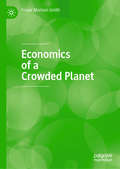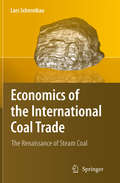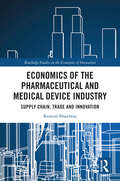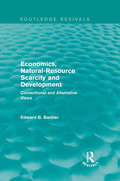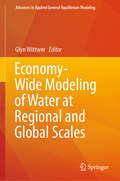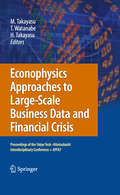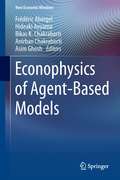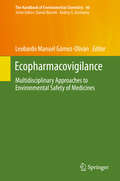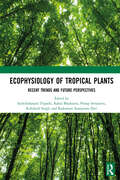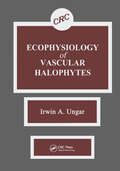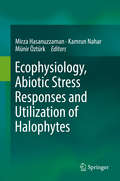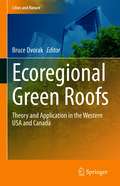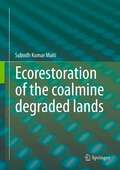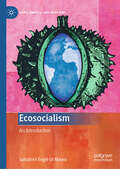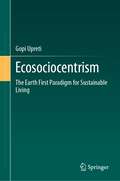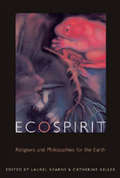- Table View
- List View
Economics of a Crowded Planet
by Fraser Murison SmithThis book asks the question, how would economics look today and into the future if one started with a blank sheet of paper? Written mainly for a technical audience, yet accessible to the lay reader, Economics of a Crowded Planet addresses the ontology, epistemology and methodology of a future economics as if from outside the economy looking in. It presents a conceptual framework for a future economics drawing from systems science and hierarchy theory, integrating central concepts from present-day economics, so as to orient the field in a direction that can serve society’s future needs in practical ways. The exposition reveals a paradigm called ‘market planetarianism’: the idea that the power of markets may be used to steer the economy toward a desired long-term goal. Both a prescriptive doctrine and an economic methodology, it treats the economy and nature as instances of complex, evolutionary systems, demanding analytical tools quite unlike those of the 20th-century mainstream.
Economics of the International Coal Trade: The Renaissance of Steam Coal
by Lars SchernikauThe world today depends on oil, coal and gas (in that order of importance) for over 80% of its primary energy. From the time humans tamed fire, wood or bio-mass became the primary energy source. Coal took over from biomass during the Industrial Revolution and accounted for over 60% of world primary energy by the early 1900s. The current age is often referred to as the Oil Age, which seems appropriate now that about 35% of the world's primary energy still comes from oil. However, coal is experiencing a renaissance. Today about one quarter of the world's primary energy and more than 40% of the world's electricity comes from coal. In addition, about two thirds of the world's steel is produced using coal. The author predicts that coal will become even more important in the decades to come, mainly driven by demand from China and India. This book focuses on the role of coal for today's energy and, most importantly, electricity markets. It starts with a review of coal as a resource, profiling the major steam coal exporting nations and the structure of the supply market. The low investment rate in coal compared to other fossil fuels is discussed, and environmental and safety issues with coal production are reviewed. The book examines how coal is used in the modern world. It compares coal to other energy resources and speculates on a greater role for coal in the medium-term future. It examines the structure of the steam coal market, contract terms, derivative markets, FOB costs, and introduces the WorldCoal market model. The final chapter summarizes conclusions and predictions. The author predicts more and larger merger attempts in the coal supply arena and further efforts to manage this development through public policy, greater investment by market participants in logistics and upstream assets, and the development of exchange-based coal trading through standardized coal volumes. The author also outlines why he believes coal prices will rise, eventually catching up with gas.
Economics of the Pharmaceutical and Medical Device Industry: Supply Chain, Trade and Innovation (Routledge Studies in the Economics of Innovation)
by Ramesh BhardwajThis book provides a comprehensive examination of the pharmaceutical and medical device industry, including analysis of its current trade and innovation strategies.Opening with a survey of the global pharmaceutical and medical device industry, Bhardwaj outlines the growing trade and trade interdependence among countries in the global supply chain. He adopts a trade competitiveness approach to analyze patterns of product specialization and examines the drug discovery process and its challenges in translating bioscientific knowledge into lifesaving products. Bhardwaj argues that further economic integration, collaborative R&D, and digital technologies may help accelerate productivity and address global challenges of escalating drug costs, neglected tropical diseases (NTDs), and pandemic risks. The book also considers how the industry may further green its supply chain, and thus contribute to SDG Goals 3 (Good Health and Wellbeing) and 12 (Responsible Consumption and Production), before closing on a review of China and India, major players who have the potential to become drivers of low-cost medical products and innovations.With its evidence-based analysis, this book will be of great interest to researchers in pharmaceutical studies, supply chain management, global health, and health economics, as well as policymakers and professionals interested in the global issues facing the industry.
Economics, Natural-Resource Scarcity and Development: Conventional and Alternative Views (Routledge Revivals)
by Edward B BarbierGlobal warming is an increasing problem, tropical forests are being wiped out and major upper watersheds are being degraded. Using insights provided by environmentalism, ecology and thermo-dynamics, this book – first published in 1989 – outlines an economic approach to the use of natural resources and particularly to the problem of environmental degradation. Edward Barbier reviews and critiques the long past of environmental and resource economics and then goes on to elaborate an economics which allows us to develop alternative strategies for dealing with the problems faced. With examples drawn from Latin America and Indonesia, he not only develops a major theoretical advance but shows how it can be applied. Barbier’s work is an important and relevant contribution to the discussion surrounding the economics of environmental sustainability.
Economy Of Machinery And Manufacture #2
by Charles Babbage"...it was my intention to have delivered the present work in the form of a course of lectures at Cambridge; an intention which I was subsequently induced to alter. The substance of a considerable portion of it has, however, appeared among the preliminary chapters of the mechanical part of the Encyclopedia Metropolitana."
Economy-Wide Modeling of Water at Regional and Global Scales (Advances in Applied General Equilibrium Modeling)
by Glyn WittwerThis book deals with the economic modelling of water at the global, national and sub-national levels. It presents a multi-faceted analysis and, while it outlines the theories behind various models, its main purpose is to analyse policy issues and present insights arising from modelling, including a chapter analysing the macroeconomic implications of climate change. Arguably the most compelling reason for publishing a book on the economic modelling of water arises from the fact that agriculture accounts for approximately 70% of water used for economic purposes, while only contributing 4% of global income. Given that water is an essential commodity, this discrepancy may in part be symptomatic of an undervaluation of water due to immature and incomplete markets. In turn, this undervaluation has led to an ongoing misallocation of water. When economic models include water accounts that feed into production functions, they model impacts on the marginal product of water. Policies that improve the link between the marginal product and price of water will improve water allocation, while advanced economic models such as those presented here can enhance our ability to explore the possible impacts of improved policy.
Econophysics Approaches to Large-Scale Business Data and Financial Crisis: Proceedings of Tokyo Tech-Hitotsubashi Interdisciplinary Conference + APFA7
by Tsutomu Watanabe Hideki Takayasu Misako TakayasuThe new science of econophysics has arisen out of the information age. As large-scale economic data are being increasingly generated by industries and enterprises worldwide, researchers from fields such as physics, mathematics, and information sciences are becoming involved. The vast number of transactions taking place, both in the financial markets and in the retail sector, is usually studied by economists and management and now by econophysicists. Using cutting-edge tools of computational analysis while searching for regularities and "laws" such as those found in the natural sciences, econophysicists have come up with intriguing results. The ultimate aim is to establish fundamental data collection and analysis techniques that embrace the expertise of a variety of academic disciplines. This book comprises selected papers from the international conference on novel analytical approaches to economic data held in Tokyo in March 2009. The papers include detailed reports on the market behavior during the financial crisis of 2008 and discussions on the mechanism of bubbles and crashes, with proposals for avoiding new crises. Filled with up-to-date research, this book will interest researchers and students, finance professionals, and scholars in diverse fields.
Econophysics and Companies: Statistical Life and Death in Complex Business Networks
by Hideaki Aoyama Yoshi Fujiwara Yuichi Ikeda Hiroshi Iyetomi Wataru SoumaEconophysics is an emerging interdisciplinary field that takes advantage of the concepts and methods of statistical physics to analyse economic phenomena. This book expands the explanatory scope of econophysics to the real economy by using methods from statistical physics to analyse the success and failure of companies. Using large data sets of companies and income-earners in Japan and Europe, a distinguished team of researchers show how these methods allow us to analyse companies, from huge corporations to small firms, as heterogeneous agents interacting at multiple layers of complex networks. They then show how successful this approach is in explaining a wide range of recent findings relating to the dynamics of companies. With mathematics kept to a minimum, the book is not only a lively introduction to the field of econophysics but also provides fresh insights into company behaviour.
Econophysics of Agent-based models
by Bikas K. Chakrabarti Anirban Chakraborti Hideaki Aoyama Frédéric Abergel Asim GhoshThe primary goal of this book is to present the research findings and conclusions of physicists, economists, mathematicians and financial engineers working in the field of "Econophysics" who have undertaken agent-based modelling, comparison with empirical studies and related investigations. Most standard economic models assume the existence of the representative agent, who is "perfectly rational" and applies the utility maximization principle when taking action. One reason for this is the desire to keep models mathematically tractable: no tools are available to economists for solving non-linear models of heterogeneous adaptive agents without explicit optimization. In contrast, multi-agent models, which originated from statistical physics considerations, allow us to go beyond the prototype theories of traditional economics involving the representative agent. This book is based on the Econophys-Kolkata VII Workshop, at which many such modelling efforts were presented. In the book, leading researchers in their fields report on their latest work, consider recent developments and review the contemporary literature.
Ecopharmacovigilance
by Leobardo Manuel Gómez-OlivánThe indiscriminate use of medications and their inadequate disposal have resulted in them being released into the environment via municipal, hospital and industrial discharges. This volume critically examines the presence of pharmaceuticals in aquatic ecosystems, the hazards they entail, and how to minimize their impact on the environment. The topics covered include: historical findings that have made the development of the discipline ecopharmacovigilance possible; the main exposure routes, fate and life cycle of pharmaceuticals in water; occurrence data and the impact on biodiversity; methods used for the detection, analysis and quantification of pharmaceuticals in water and for their removal; current legislation on the presence of emerging contaminants in water; biosensors for environmental analysis and monitoring; and the measures needed to reduce the existing problems. This book is aimed at students, academics and research workers in the fields of toxicology, ecology, microbiology and chemistry, as well as those in the pharmaceutical industry, health sector professionals, and members of government bodies involved in environmental protection and legislation.
Ecophysiology and Biochemistry of Cyanobacteria
by Rajesh Prasad RastogiThis book emphasizes and presents the latest information on eco-physiology and biochemistry of cyanobacteria with special emphasis on their biodiversity, molecular mechanisms of some important biological processes and survival mechanisms under myriad of environmental conditions as well as bioremediation. Cyanobacteria are the most dominant prokaryotic floras on the Earth’s surface, and are of great importance in terms of ecological, economical and evolutionary perspectives. They are oldest groups of photosynthetic autotrophs, which create oxygenic atmosphere for the development and sustainability of ecosystems with different life forms. The book presents an integrative approach to their possible biotechnological application in the field of bio-energy and various aspects of biochemistry, biophysics and structural biology of photosynthesis. The various chapters describe the different applications of cyanobacteria as bio-energy sources and in phycoremediation. The contents incorporated in this book can be used as a textbook by undergraduate and post-graduate students, teachers, and researchers in the most interesting fields of physicochemical ecology and biochemistry of cyanobacteria.
Ecophysiology and Responses of Plants under Salt Stress
by Parvaiz Ahmad M.N.V. Prasad M. M. AzoozThis book will shed light on the effect of salt stress on plants development, proteomics, genomics, genetic engineering, and plant adaptations, among other topics. Understanding the molecular basis will be helpful in developing selection strategies for improving salinity tolerance. The book will cover around 25 chapters with contributors from all over the world.
Ecophysiology of Tropical Plants: Recent Trends and Future Perspectives
by Rishikesh Singh Rahul Bhadouria Sachchidanand Tripathi Pratap Srivastava Rajkumari Sanayaima DeviPlants in tropical regions are coping with enormous challenges of physiological stresses owing to changing environmental and climatic conditions. Rapid growth of human population and rampant exploitation of fossil fuels and other developmental activities are actively contributing to such perturbations. The Intergovernmental Panel on Climate Change has projected a sustained increase in carbon dioxide (CO2) emissions and thereby a rise in global temperature in the coming decades. The resultant changes in precipitation patterns are now evident across the globe due to intensication of hydrological cycle. Moreover, gaseous and particulate pollutants are also an immense challenge for tropical plants. Such vagaries in environmental conditions have signicant impacts on the ecophysiological traits of plants, resulting from altered interactions of tropical plants with each other, as well as other biotic and abiotic components within the ecosystem. Books available in the market that particularly focus on ecophysiological responses of tropical plants to abiotic and biotic environmental factors under climate change are limited. This book intends to fill this knowledge gap and provides a detailed analysis on ecophysiological responses of tropical plants to these environmental challenges, as well as suggesting some approachable measures for plant adaptations to these challenges. The book is equally applicable to undergraduate and postgraduate students, researchers, teachers and forest managers, and policy makers. Salient features of the book are: 1. A comprehensive discussion on adaptive mechanisms of plants through their ecophysiological responses to various biotic and abiotic stresses. 2. Elaboration on the recent techniques involved in ecophysiological research. 3. A detailed account of evolutionary responses of plants to changing climate. 4. Discussion of recent research results and some pointers to future advancements in ecophysiological research. 5. Presentation of information in a way that is accessible for students, researchers, and teachers practicing in plant physiology and ecology.
Ecophysiology of Vascular Halophytes
by Irwin A. UngarEcophysiology of Vascular Halophytes provides a useful update to existing literature describing the ecophysiological responses of vascular halophytes to environmental stresses present in saline habitats. The success of species growing in these extreme environments is related to a number of adaptations, including the timing of phenological events, phenotypic plasticity and genetic selection for specific ecophysiological responses at different stages of development. Factors discussed that influence the growth and distribution of halophytes include seed germination, salinity stress, salt stimulation, flooding, ion content, nitrogen, plant water status, growth regulators, photosynthesis, and genecology. The book also discusses the effects of both interspecific and intraspecific competition on the growth and survival of halophytes. Researchers and students of stress ecology, as well as agricultural research organizations, will find a tremendous store of information in this volume.
Ecophysiology, Abiotic Stress Responses and Utilization of Halophytes
by Münir Öztürk Mirza Hasanuzzaman Kamrun NaharHalophytes are those plant species that can tolerate high salt concentrations. There are diversified species of halophytes suited for growth in various saline regions around the world, e.g. coastal saline soil, soils of mangrove forests, wetlands, marshlands, lands of arid and semiarid regions, and agricultural fields. These plants can be grown in soil and water containing high salt concentrations and unsuitable for conventional crops, and can be good sources of food, fuel, fodder, fiber, essential oils, and medicine. Moreover, halophytes can be exploited as significant and major plant species for the desalination and restoration of saline soils, as well as phytoremediation. This book highlights recent advances in exploring the unique features of halophytes and their potential uses in our changing environment.
Ecopolitics: The Environment in Poststructuralist Thought (Opening Out: Feminism for Today)
by Verena Andermatt ConleyEcopolitics is a study of environmental awareness - or non-awareness - in contemporary French theory. Arguing that it is now impossible not to think in an ecological way, Verena Andermatt Conley traces the roots of today's concern for the environment back to the intellectual climate of the late 50s and 60s.The author considers key texts by influential figures such as Michael Serres, Paul Virilio, Gilles Deleuze and Felix Guattari, Michel de Certeau, Hélène Cixous and Luce Irigaray. Ecopolitics rehabilitates some ecological components of French intellectual thought of the past thirty years, and reassesses French poststructural thinkers who explicitly deal with ecology in their work.
Ecoregional Green Roofs: Theory and Application in the Western USA and Canada (Cities and Nature)
by Bruce DvorakThis book studies the application of green roofs in ecoregions of the western United States and Canada. While green roofs were intended to sustain local or regional vegetation, this volume describes how green roofs in their modern form are typically planted with a low-diversity mix of sedums from Europe or Asia. The authors demonstrate how in the western USA and Canada many green roofs have been designed with native plants and have been found to thrive.Part I of this book covers theory and an overview of ecoregions and their implications for green roofs. In Part II vegetation from prairies, deserts, montane meadows, coastal meadows, and scrub and sub-alpine habitats are explored on seventy-three ecoregional green roofs. Case studies explore design concepts, materials, watering and maintenance, wildlife, plant species, and lessons learned. Part III covers an overview of ecoregional green roofs and a future outlook.This book is aimed at professionals, designers, researchers, students and educators with an interest in green roofs and the preservation of biodiversity.
Ecorestoration of the coalmine degraded lands
by Subodh Kumar MaitiThe book adopts an application-oriented approach for ecorestoration of coalmine degraded. The theoretical aspects of ecorestoration, and steps involved in ecorestoration process and experimental aspects of thorough analytical procedures have been discussed in detail. It emphasizes on the types of mining, land degradation, and biodiversity conservation while giving details of technical and biological steps, topsoil management, selection of plant species, seeding, nursery practices; adoption of innovative approaches like mulching, biofertlizer application, hydroseeding, superabsorbent; use of grass-legume mix; monitoring and aftercare of reclaimed sites; the indicators of sustainable ecorestoration; and Rules and Acts implemented and followed across the world. Best ecorestoration practices, mine closure issues, collection, laboratory analysis and interpretation of minesoil and topsoil samples, monitoring biological parameters, litterfall and tree growth analysis, erosion management, design of drainage and sedimentation retention basin, and brief description of tree species with identifying character for field people are all part of the book. [Message by Prominent Academician] It is now urgent that methods of coal mining be integrated with engineering for ecorestoration because the larger society will not accept devastated waste land. A book, coming out from the hands of one of the persistent researchers of the field, cannot be more timely. Jayanta Bhattacharya, PhD FNAE Professor, Department of Mining Engineering Indian Institute of Technology, Kharagpur-721302, India.
Ecosickness in Contemporary U.S. Fiction
by Heather HouserThe 1970s brought a new understanding of the biological and intellectual impact of environmental crises on human beings, and as efforts to prevent ecological and human degradation aligned, a new literature of sickness emerged. "Ecosickness fiction" imaginatively rethinks the link between ecological and bodily endangerment and uses affect and the sick body to bring readers to environmental consciousness.Tracing the development of ecosickness through a compelling archive of modern U.S. novels and memoirs, this study demonstrates the mode's crucial role in shaping thematic content and formal and affective literary strategies. Examining works by David Foster Wallace, Richard Powers, Leslie Marmon Silko, Marge Piercy, Jan Zita Grover, and David Wojnarowicz, Heather Houser shows how these authors unite experiences of environmental and somatic damage through narrative affects that draw attention to ecological phenomena, organize perception, and convert knowledge into ethics. Traversing contemporary cultural studies, ecocriticism, affect studies, and literature and medicine, Houser juxtaposes ecosickness fiction against new forms of environmentalism and technoscientific innovations such as regenerative medicine and alternative ecosystems. Ecosickness in Contemporary U.S. Fiction recasts recent narrative as a laboratory in which affective and perceptual changes both support and challenge political projects.
Ecosickness in Contemporary U.S. Fiction: Environment and Affect (Literature Now)
by Heather HouserThe 1970s brought a new understanding of the biological and intellectual impact of environmental crises on human beings. As efforts to prevent ecological and bodily injury aligned, a new literature of sickness emerged. "Ecosickness fiction" imaginatively rethinks the link between these forms of threat and the sick body to bring readers to environmental consciousness. Tracing the development of ecosickness through a compelling archive of contemporary U.S. novels and memoirs, Ecosickness in Contemporary U.S. Fiction establishes that we cannot comprehend environmental and medical dilemmas through data alone and must call on the sometimes surprising emotions that literary metaphors, tropes, and narratives deploy. In chapters on David Foster Wallace, Richard Powers, Leslie Marmon Silko, Marge Piercy, Jan Zita Grover, and David Wojnarowicz, Heather Houser shows how narrative affects such as wonder and disgust organize perception of an endangered world and orient us ethically toward it. The study builds the connective tissue between contemporary literature, ecocriticism, affect studies, and the medical humanities. It also positions ecosickness fiction relative to emergent forms of environmentalism and technoscientific innovations such as regenerative medicine and alternative ecosystems. Houser models an approach to contemporary fiction as a laboratory for affective changes that spark or squelch ethical projects.
Ecosocialism: An Introduction (Marx, Engels, and Marxisms)
by Salvatore Engel-Di MauroThis book offers an extensive critical overview of eco-socialism, one of the most generative and significant aspects of contemporary debates within socialism. Marxism has played a foundational role in the development of ecosocialism since its inception and has also led to critical reflections on the 20th century Marxism and ecological interpretation of Marxist writings. Despite the relevance of ecosocialism to the pressing debates on the ecological crisis and the growing literature on ecosocialism, there has not been a comprehensive account on ecosocialism and its variations. This volume seeks to fill this important gap and to pave the way for a more systematic development of this emerging paradigm. The book not only engages with a critique of other non-socialist ecological schools of thought in defence of ecosocialism, but also provides a critical overview of debates within ecosocialism and of ecosocialism itself. The latter includes an appraisal of ecosocialism in Bolivarian Venezuela and the implications of current efforts in the People's Republic of China to build an ecological civilisation. Furthermore, the book contains a crucial discussion about the relation between eco-socialism and indigenous studies and movements.
Ecosociocentrism: The Earth First Paradigm for Sustainable Living
by Gopi UpretiThis book, on the subject of global environmental crisis and climate change that has threatened the very existence of humankind and the living system on planet Earth, claims that the current Anthropocene is the most dangerous era of environmental, and ecological crisis the planet Earth has ever witnessed. This book not only insightfully reflects upon the crisis manifested by climate change, breakdown of planetary ecosystem, extinction and annihilation of millions of species, acidification of oceans, desertification of productive lands, and toxic pollution attributing to the current dominant neoliberal economic model but also presents a new ethical development framework that recognizes and promotes the instrumental, relational and intrinsic values in the Earth system which form the basis for social and environmental sustainability. This is a useful book for all stakeholders involved in environmental protection, UN, and development agencies, INGOs, civil societies, NGOs, governments officials and professionals, media personnel, universities faculties, students, and researchers.
Ecospirit: Religions and Philosophies for the Earth (Transdisciplinary Theological Colloquia)
by Catherine Keller Laurel KearnsWe hope—even as we doubt—that the environmental crisis can be controlled. Public awareness of our species’ self-destructiveness as material beings in a material world is growing—but so is the destructiveness. The practical interventions needed for saving and restoring the earth will require a collective shift of such magnitude as to take on a spiritual and religious intensity.This transformation has in part already begun. Traditions of ecological theology and ecologically aware religious practice have been preparing the way for decades. Yet these traditions still remain marginal to society, academy, and church. With a fresh, transdisciplinary approach, Ecospirit probes the possibility of a green shift radical enough to permeate the ancient roots of our sensibility and the social sources of our practice. From new language for imagining the earth as a living ground to current constructions of nature in theology, science, and philosophy; from environmentalism’s questioning of postmodern thought to a garden of green doctrines, rituals, and liturgies for contemporary religion, these original essays explore and expand our sense of how to proceed in the face of an ecological crisis that demands new thinking and acting. In the midst of planetary crisis, they activateimagination, humor, ritual, and hope.
Ecosystem Approaches to Fisheries
by Villy Christensen Jay MacleanInspired by the work of the renowned fisheries scientist Daniel Pauly, this book provides a detailed overview of ecosystem-based management of fisheries. It explores the complex and interdisciplinary nature of the subject by bringing together contributions from some of the world's leading fisheries scientists, managers and conservationists. Combining both research reviews and opinion pieces, and reflecting the breadth of Pauly's influence within the field, the book illustrates the range of issues associated with the implementation of the ecosystem approach and the challenge of long-term sustainability. Topics covered include global biodiversity, the impact of human actions on marine life, the implications for economic and social systems and the role of science in communicating and shaping ocean policy to preserve resources for the future. This book provides a complete and essential overview for advanced researchers and those just entering the field.
